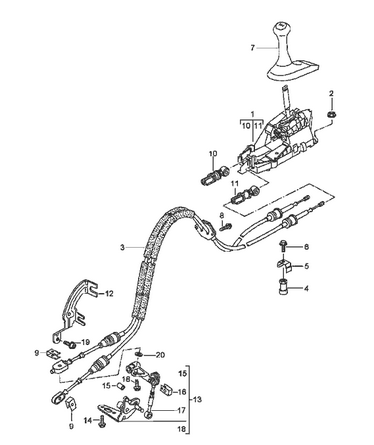Pushmi-Pullyu: The Private Lives of Gearchange Linkages
In the olden days, when horseless carriages had an engine in the front, a driven axle at the back and a gearbox in the middle, life was simple. The gearstick stuck up out of the gearbox, usually with a simple extension piece to place the gearstick next to the steering wheel instead of somewhere under the dash and it didn’t take much cleverness to work out how the driver’s movement of the gearstick was fed into the gearbox. The driver moved a stick and the stick did stuff in the innards of the gearbox to change gears.
But cars that shun the simple front engine rear wheel drive design, such as MINI’s and Porsches need a more complex arrangement to allow the driver to change gear. The original 911 used a system of rods and linkages to change gears. Variations of this mechanism were used up to the 993 model 911. With the Boxster in 1997 and its big brother, the 996 generation of 911 in 1999, Porsche adopted cable-operated gear selection.
A cable operated gear selector uses two cables. One cable has the job of transmitting the fore and aft movement from the gear stick to the gear selector on the gearbox and the other cable (via a bell crank on the gear selector) transmits the left to right movement back to the gearbox, where a second bell crank converts the pushes and pulls back to side to side movements.
A diagram showing the components of the Porsche Boxster gear selector mechanism:

There are advantages to using a cable operated system. A rod system such as that used on aircooled 911’s goes through a series of bushes. As those bushes wear over time, sloppiness is introduced to the system. Dirt and grime in the bushes can also interfere with gear selection. During vehicle assembly, setting up cables is simpler than configuring a system of rods and linkages. Over time, car interiors have become quieter, and gear cables can contribute to the quietness; a system of rods will transmit noise into the cabin. Hand in hand with that, is the fact that cables can insulate the driver from how the engine and transmission are moving about. This means that the gear stick is exactly where the driver left it, no matter how the engine and transmission move on their mountings, and a related advantage is that the car can’t knock itself out of gear because the cables bend and flex, unlike rods.
The potential advantage of a rod system is that it can provide a more precise gear change, although in truth, a well designed and properly set up cable system can feel every bit as precise.



Comment(s)0